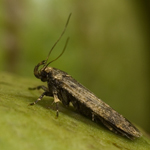Countering Insect Resistance with Designer Bt Toxins
Media Contact:
Jennifer Martin, (202) 720-8188
By Stacy Kish, CSREES Staff
July 7, 2008

A pink bollworm ( Pectinophora gossypiella ) moth perched on a cotton boll.
Credit:
Alex Yelich
Toxins from the bacterium Bacillus thuringiensis (Bt) kill some key agricultural pests, but cause little or no harm to people, wildlife, and even most other insects, including the natural enemies of pests. For decades, Bt toxins were used successfully in organic and mainstream agriculture. Widespread exposure to Bt toxins, however, increases the chances that pests will adapt and evolve resistance - just as pests have evolved resistance to conventional insecticides. With funding from Cooperative State Research, Education, and Extension Service (CSREES), researchers in Arizona and Mexico have collaborated to design, create and test genetically-modified Bt toxins that kill insects resistant to standard Bt toxins.
Since 1996, cotton and corn crops have been genetically engineered to produce their own Bt toxins. These crops have grown on more than 490 million acres worldwide, with most of that acreage in the United States. With Bt toxins increasingly important for pest control and the threat of resistance also mounting, the modified toxins could help to protect the nation's food supply and promote sustainable, environmentally friendly agriculture.
The Bt toxins used most widely in sprays and, Bt-modified crops are insecticidal crystal proteins in the Cry1A family, which are effective against some of the most damaging crop-munching caterpillars. After Cry1A toxins are ingested by caterpillars, they are activated by enzymes in the alkaline caterpillar gut. These activated Cry1A toxins bind to specific receptors on the insects' midgut membrane. This creates holes in the membrane, eventually causing the caterpillar's death.
The binding to a caterpillar's midgut receptor by a Cry1A toxin is like the fit between a lock and key. Each Bt toxin is like a key that fits only certain receptors, which are like locks. The best-known mechanism of insect resistance to Bt toxins involves changes in the receptors. In effect, the lock is altered so the key won't fit. This allows resistant insects to survive exposure to the toxin.
Bruce Tabashnik and his colleagues at the University of Arizona determined that lab-selected resistance to Cry1A toxins in pink bollworm (Pectinophora gossypiella), a major cotton pest in the southwestern United States, is tightly linked with specific genetic mutations. These mutations occur in a gene that carries instructions for making a receptor protein called cadherin that binds Cry1A toxins. The researchers determined that resistance to Bt toxin occurs when mutations inhibit the cadherin gene from properly binding with Cry1A.
Meanwhile, Mario Soberón, Alejandra Bravo and their colleagues at the Universidad Nacional Autónoma de Mexico, hypothesized that this type of resistance to Cry1A toxins could be overcome by modified toxins that do not require binding to cadherin to kill caterpillars. Using knowledge from the study, the scientists designed and created modified toxins called Cry1AMod toxins. Subsequent tests at the University of Arizona showed that Cry1A-resistant pink bollworm caterpillars were killed by the Cry1AMod toxins, suggesting the modified toxins may be useful for countering or delaying resistance to standard Bt toxins in caterpillar pests.
CSREES funded this project through the National Research Initiative Arthropod and Nematode Biology and Management program. Through federal funding and leadership for research, education and extension programs, CSREES focuses on investing in science and solving critical issues impacting people's daily lives and the nation's future. For more information, visit www.csrees.usda.gov.
###
Last Updated: 07/07/2008





